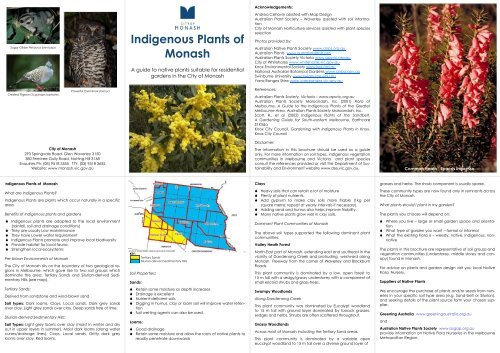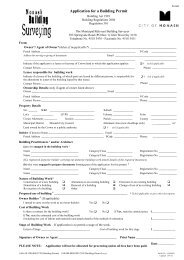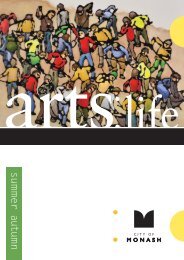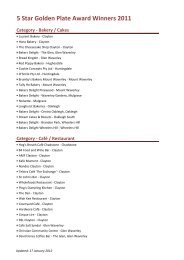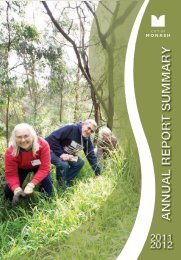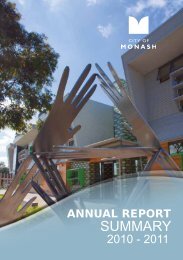Indigenous Plants of Monash - City of Monash
Indigenous Plants of Monash - City of Monash
Indigenous Plants of Monash - City of Monash
Create successful ePaper yourself
Turn your PDF publications into a flip-book with our unique Google optimized e-Paper software.
Sugar Glider Petaurus breviceps<br />
<strong>Indigenous</strong> <strong>Plants</strong> <strong>of</strong><br />
<strong>Monash</strong><br />
A guide to native plants suitable for residential<br />
gardens in the <strong>City</strong> <strong>of</strong> <strong>Monash</strong><br />
Acknowledgements:<br />
Andrea Cehovin assisted with Map Design<br />
Australian Plant Society – Waverley assisted with soil information<br />
<strong>City</strong> <strong>of</strong> <strong>Monash</strong> Horticulture services assisted with plant species<br />
selection<br />
Photos provided by:<br />
Australian Native <strong>Plants</strong> Society www.anps.org.au<br />
Australian <strong>Plants</strong> www.australiaplants.org<br />
Australian <strong>Plants</strong> Society Victoria www.apsvic.org.au<br />
<strong>City</strong> <strong>of</strong> Whitehorse www.whitehorse.vic.gov.au<br />
Knox Environmental Society www.kes.org.au<br />
National Australian Botanical Gardens www.anbg.gov.au<br />
Swinburne University www.swinburne.edu.au<br />
Yarra Ranges Shire www.yarraranges.vic.gov.au<br />
Crested Pigeon Ocyphaps lophotes<br />
Powerful Owl Ninox strenua<br />
References:<br />
Australian <strong>Plants</strong> Society, Victoria – www.apsvic.org.au<br />
Australian <strong>Plants</strong> Society Maroondah, Inc (2001) Flora <strong>of</strong><br />
Melbourne. A Guide to the <strong>Indigenous</strong> <strong>Plants</strong> <strong>of</strong> the Greater<br />
Melbourne Area, Australian <strong>Plants</strong> Society Maroondah, Inc.<br />
Scott, R., et al (2002) <strong>Indigenous</strong> <strong>Plants</strong> <strong>of</strong> the Sandbelt.<br />
A Gardening Guide for South-eastern Melbourne, Earthcare<br />
St Kilda<br />
Knox <strong>City</strong> Council, Gardening with <strong>Indigenous</strong> <strong>Plants</strong> in Knox,<br />
Knox <strong>City</strong> Council<br />
Disclaimer:<br />
<strong>City</strong> <strong>of</strong> <strong>Monash</strong><br />
293 Springvale Road, Glen Waverley 3150<br />
380 Ferntree Gully Road, Notting Hill 3168<br />
Enquiries Ph: (03) 9518 3555 TTY: (03) 9518 3655<br />
Website: www.monash.vic.gov.au<br />
The information in this brochure should be used as a guide<br />
only. For more information on soil types, indigenous vegetation<br />
communities in Melbourne and Victoria and plant species<br />
consult the references provided or visit the Department <strong>of</strong> Sustainability<br />
and Environment website www.dse.vic.gov.au.<br />
Common Heath Epacris impressa<br />
<strong>Indigenous</strong> <strong>Plants</strong> <strong>of</strong> <strong>Monash</strong><br />
Clays<br />
grasses and herbs. The shrub component is usually sparse.<br />
What are <strong>Indigenous</strong> <strong>Plants</strong>?<br />
<strong>Indigenous</strong> <strong>Plants</strong> are plants which occur naturally in a specific<br />
area.<br />
Benefits <strong>of</strong> <strong>Indigenous</strong> plants and gardens<br />
Heavy soils that can retain a lot <strong>of</strong> moisture<br />
Plenty <strong>of</strong> plant nutrients.<br />
Add gypsum to make clay soils more friable (1kg per<br />
square metre; repeat at yearly intervals if necessary).<br />
Adding sand and humus also helps improve friability.<br />
Many native plants grow well in clay soils.<br />
These community types are now found only in remnants across<br />
the <strong>City</strong> <strong>of</strong> <strong>Monash</strong>.<br />
What plants should I plant in my garden?<br />
The plants you choose will depend on:<br />
<strong>Indigenous</strong> plants are adapted to the local environment<br />
(rainfall, soil and drainage conditions)<br />
They are usually Low maintenance<br />
They have Lower water requirement<br />
<strong>Indigenous</strong> <strong>Plants</strong> promote and improve local biodiversity<br />
Provide habitat for local fauna<br />
Strengthen local ecosystems<br />
Pre-Urban Environments <strong>of</strong> <strong>Monash</strong><br />
The <strong>City</strong> <strong>of</strong> <strong>Monash</strong> sits on the boundary <strong>of</strong> two geological regions<br />
in Melbourne, which gave rise to two soil groups which<br />
dominate the area: Tertiary Sands and Silurian-derived Sedimentary<br />
Hills (see map).<br />
KEY:<br />
Soil Properties:<br />
Sands:<br />
Tertiary Sands<br />
Silurian-derived Sedimentary Hills<br />
Dominant Plant Communities <strong>of</strong> <strong>Monash</strong><br />
The above soil types supported the following dominant plant<br />
communities:<br />
Valley Heath Forest<br />
North-East part <strong>of</strong> <strong>Monash</strong>, extending east and southeast in the<br />
vicinity <strong>of</strong> Dandenong Creek and protruding westward along<br />
<strong>Monash</strong> Freeway from the corner <strong>of</strong> Waverley and Blackburn<br />
Roads.<br />
This plant community is dominated by a low, open forest to<br />
15 m tall with a sedgy/grassy understorey with a component <strong>of</strong><br />
small ericoid shrubs and grass-trees.<br />
Where you live – large or small garden space and orientation<br />
What type <strong>of</strong> garden you want – formal or informal<br />
What the existing Flora is – weedy, native, indigenous, nonnative<br />
The plants in this brochure are representative <strong>of</strong> soil groups and<br />
vegetation communities (understorey, middle storey and canopy)<br />
found in <strong>Monash</strong>.<br />
For advice on plants and garden design visit you local Native<br />
Flora Nursery.<br />
Suppliers <strong>of</strong> Native <strong>Plants</strong><br />
Tertiary Sands:<br />
Derived from sandstone and wind-blown sand<br />
Soil types: Dark loams, Clays, Local sands, Dark grey sands<br />
over clay, Light grey sands over clay, Deep sands free <strong>of</strong> lime.<br />
Silurian-derived Sedimentary Hills:<br />
Soil Types: Light grey loams over clay (moist in winter and dry<br />
out in upper layers in summer), Moist dark loams (along water<br />
curses/drainage lines), Clays, Local sands, Gritty dark grey<br />
loams over clay, Red loams.<br />
Retain some moisture as depth increases<br />
Drainage is excellent<br />
Nutrient-deficient soils<br />
Digging in humus, clay or loam soil will improve water retention<br />
Soil wetting agents can also be used.<br />
Loams:<br />
Good drainage<br />
Retain some moisture and allow the roots <strong>of</strong> native plants to<br />
readily penetrate downwards<br />
Swampy Woodlands<br />
Along Dandenong Creek<br />
This plant community was dominated by Eucalypt woodland<br />
to 15 m tall with ground layer dominated by tussock grasses,<br />
sedges and herbs. Shrubs are <strong>of</strong>ten scattered throughout.<br />
Grassy Woodlands<br />
Across most <strong>of</strong> <strong>Monash</strong> including the Tertiary Sand areas.<br />
This plant community is dominated by a variable open<br />
eucalypt woodland to 15 m tall over a diverse ground layer <strong>of</strong><br />
We encourage the purchase <strong>of</strong> plants and/or seeds from nurseries<br />
in your specific soil type area (e.g. Sand-belt or Silurian),<br />
and seeking details <strong>of</strong> the plant source form your chosen supplier.<br />
Greening Australia www.greeningaustralia.org.au<br />
and<br />
Australian Native <strong>Plants</strong> Society www.asgap.org.au<br />
provide information on Native Flora Nurseries in the Melbourne<br />
Metropolitan Region.
Ground Cover<br />
Thin Leaf Wattle<br />
Climbers<br />
Size:<br />
Description:<br />
Flowering:<br />
Requirements:<br />
Features:<br />
Acacia aculeatissima<br />
Low <strong>Plants</strong><br />
Creeping Bossiaea Bossiaea prostrata Button Everlasting Helichrysum sorpioides<br />
Size:<br />
Description:<br />
Flowering:<br />
Requirements:<br />
Features:<br />
Cup-Leaf Daisy<br />
Size:<br />
Description:<br />
Flowering:<br />
Requirements:<br />
Features:<br />
Running Postman<br />
Size:<br />
Description:<br />
Flowering:<br />
Requirements:<br />
Features:<br />
Common Apple Berry<br />
Size:<br />
Description:<br />
Flowering:<br />
Requirements:<br />
Features:<br />
Small-leaf Clematis<br />
Size:<br />
Description:<br />
Flowering:<br />
Requirements:<br />
Features:<br />
Brachyscome multifida<br />
Kennedia prostrata<br />
Billardiera scandens<br />
Clematis microphylla<br />
Billy-Button<br />
Erect Guinnea Flower<br />
Dwarf-Rice-Flower<br />
Myrtle Wattle<br />
Showy Bossiaea<br />
Craspedia variabilis<br />
Hibbertia stricta<br />
Pilelea Humilis<br />
Acacia myrtifolia<br />
Bossiaea cinerea<br />
Purple Coral Pea Hardenbergia violacea Snowy Daisy Bush Olearia lirata<br />
Size:<br />
Description:<br />
Flowering:<br />
Requirements:<br />
Features:<br />
Mountain Clematis Clematis aristata Dusty Miller Spyridium parvifolium<br />
Size:<br />
Description:<br />
Flowering:<br />
Requirements:<br />
Features:<br />
0.2-0.6m H x 1-2m W<br />
Light open sprawling shrub with prickly<br />
phyllodes and yellow balls along wiry<br />
branches<br />
June to December<br />
Dry, well drained soil; Partial sun/shade<br />
Once established tolerates extended dry<br />
periods; Birds - Seeds<br />
Prostrate x 0.5-1.5m H<br />
Spreading or matting ground cover with<br />
grey-green leaves and yellow and brown<br />
pea flowers<br />
October to November<br />
Well drained, dry to moist soils; all aspects<br />
Attractive foliage; Birds - Seeds<br />
10-40cm H x 0.2-1m W<br />
Fast growing, low spreading with s<strong>of</strong>t, dark<br />
green leaves and pr<strong>of</strong>use variable lilacblue,<br />
pink and white flowers<br />
Peaking Spring and Summer<br />
Moist clay soil; full to partial sun<br />
Once established tolerates dryness; Ornamental<br />
plant; Butterflies – Nectar<br />
Prostrate x 1-2.5m H<br />
Open trailing or densely matted perennial<br />
with crinkly, hairy green-grey leaves and<br />
single scarlet pea flower-heads.<br />
April to December<br />
Dry well drained soils; Full to partial sun<br />
Drought tolerant once established; Butterfly<br />
caterpillar habitat<br />
Light, s<strong>of</strong>t climber<br />
Dark green leaves with wiry margins and<br />
greenish yellow flowers<br />
June to January<br />
Well drained dry to moist soil; Suited to all<br />
light aspects;<br />
Bushier if grown in open aspect; Edible pale<br />
green berries; Birds – Nectar, Berries<br />
Medium sized climber<br />
Dull green leaves with masses <strong>of</strong> cream<br />
tarry flowers and feathery fruits<br />
June to November<br />
Well drained dry to moist soil; partial sun/<br />
shade<br />
Male and female reproductive parts on<br />
separate plants<br />
Dense creeper/ wiry scrubber<br />
Fast growing with leathery dark green<br />
leaves and sprays <strong>of</strong> mauve to purple (to<br />
pink or white) pea<br />
July to November<br />
Dry, well drained soil;<br />
Full to partial sun; Provides Light Screen<br />
Vigorous Climber<br />
Shiny green leaves, masses <strong>of</strong> creamy white<br />
starry flowers<br />
August to March<br />
Well drained, dry to moist soils<br />
Grows in all aspects; Male and female<br />
reproductive pats on different plants; Attractive<br />
feathery seed heads<br />
Size:<br />
Description:<br />
Flowering:<br />
Requirements:<br />
Features:<br />
Size:<br />
Description:<br />
Flowering:<br />
Requirements:<br />
Features:<br />
Size:<br />
Description:<br />
Flowering:<br />
Requirements:<br />
Features:<br />
Size:<br />
Description:<br />
Flowering:<br />
Requirements:<br />
Features:<br />
Size:<br />
Description:<br />
Flowering:<br />
Requirements:<br />
Features:<br />
Size:<br />
Description:<br />
Flowering:<br />
Requirements:<br />
Features:<br />
Size:<br />
Description:<br />
Flowering:<br />
Requirements:<br />
Features:<br />
Size:<br />
Description:<br />
Flowering:<br />
Requirements:<br />
Features:<br />
30cm H x 0.5-1m W<br />
Variable tufted perennial herb with rosettes<br />
<strong>of</strong> board hairy leaves and Yellow single<br />
flowers<br />
September to November<br />
Moist well drained soil (tolerates poorly<br />
drained soil); Full to partial sun<br />
Spectacular in flower; May be grown in<br />
containers; Butterflies – Nectar<br />
30cm H x 20-30cm W<br />
Woolly spreading perennial herb with velvety/hairy<br />
leaves and a single flat yellow<br />
flower-heads per stem<br />
September-December<br />
Dry to moist well drained soils; Full to partial<br />
sun<br />
Dies back after flowering; Butterflies – Nectar<br />
0.4-1m H x 0.6-1m W<br />
Rounded to erect shrub with narrow greygreen<br />
leaves and light yellow distinctly<br />
stalked flowers<br />
Peaking August – November<br />
Moist well drained soil; All aspects<br />
Drought tolerant once established; Butterfly<br />
caterpillar habitat<br />
10-50cm H x 0.3-1m W<br />
Erect or straggling perennial sub-shrub with<br />
green and grey-green leaves and dense<br />
creamy-white flower-heads<br />
September to January<br />
Moist well drained soil; Full to partial sun<br />
Tolerates dryness once established; Butterflies<br />
Nectar<br />
1-3m Hight 1-2m Wide<br />
Fast growing rounded or erect shrub with<br />
cream to yellow flower spikes<br />
July to September<br />
Well drained, dry to moist soil; All aspects<br />
Drought resistant once established; Ornamental<br />
bush; Heavy prune may be beneficial;<br />
Birds – Seeds<br />
1-2m H x 1-2m W<br />
Dense low rounded and spreading shrub<br />
with alternate dull green (bonze new<br />
growth) leaves and pr<strong>of</strong>use single yellow<br />
and red pea flowers<br />
August to December<br />
Dry to moist well drained soil; Prefers dappled<br />
shade<br />
Ornamental; May be pruned hard<br />
2-5m H x 2-3m W<br />
S<strong>of</strong>t open shrub with dark green leaves and<br />
masses <strong>of</strong> small white flower heads<br />
September to December<br />
Moist well drained soil; Partial to full shade<br />
Excellent shrub brightening a sheltered<br />
position in spring<br />
1-3m H x 1-2m W<br />
Dense upright shrub with heavily veined,<br />
dark green leaves and clusters <strong>of</strong> small<br />
white flowers<br />
July November<br />
Dry to moist well drained soil; Partial to full<br />
shade<br />
Once established tolerates dryness; Flowers<br />
better in shady areas;<br />
Grasses, Lilies & Irises<br />
Chocolate Lily<br />
Size:<br />
Description:<br />
Flowering:<br />
Requirements:<br />
Features:<br />
Large Shrubs & Trees<br />
Wirilda<br />
Knobby Club-Rush<br />
Size:<br />
Description:<br />
Flowering:<br />
Requirements:<br />
Features:<br />
Wiry Tussock Grass<br />
Size:<br />
Description:<br />
Flowering:<br />
Requirements:<br />
Features:<br />
Grass Leaf Trigger Plant Stylidium graminiflorium<br />
Size:<br />
Description:<br />
Flowering:<br />
Requirements:<br />
Features:<br />
Size:<br />
Description:<br />
Flowering:<br />
Requirements:<br />
Features:<br />
Black She-Oak<br />
Size:<br />
Description:<br />
Flowering:<br />
Requirements:<br />
Features:<br />
Silver Banksia<br />
Size:<br />
Description:<br />
Flowering:<br />
Requirements:<br />
Features:<br />
Arthropodium atrictum<br />
2-1m H x 0.2-0.8m W<br />
Dwarf perennial herb with slightly fleshy<br />
dark green leaves and chocolate or caramel<br />
scented, solitary violet flowers<br />
September to December<br />
Dry well drained soil; Full partial sun<br />
Adaptable<br />
Isolepis nodosa<br />
0.5-1.5M H x 0.6-2m W<br />
Tall coarse, wiry, densely tufted perennial<br />
rush with clustered brown spikelets<br />
Most <strong>of</strong> the year<br />
Poorly drained moist soils, Full to partial sun<br />
Once established tolerates dryness; Good<br />
contrast plant<br />
Poa sieberiana<br />
15-30cm H x 40cm W , stems 0.9m high<br />
Dense green greyish tuft<br />
Spring and summer<br />
Moist, well drained soil; Full to partial sun<br />
Extremely variable and very adaptable;<br />
Grows larger in shade; Birds – Seeds; Butterfly<br />
caterpillar habitat<br />
0.2-0.6m H x 20-30cm W<br />
Basally tufted perennial with green and<br />
grey green grass-like leaves and spikes <strong>of</strong><br />
small pale to bright pink flowers<br />
September to December<br />
Moist, well drained soil; Full to partial sun<br />
Tolerates both wet and dry periods when<br />
established<br />
Acacia retinodes<br />
4-8m H x 3-5m W<br />
Spreading shrub with long, narrow bluishgreen<br />
phyllodes and Lemon-yellow balls<br />
Peaking November to July<br />
Adaptable to all soil types; Full to partial sun<br />
Ornamental; Suitable for wind screen; Birds<br />
- Seeds<br />
Allocasuariana littoralis<br />
4-8m H x 2-5m W<br />
Upright small tree with fine branches with<br />
reddish to crimson female flowers and dark<br />
brown pikes as male flowers<br />
March to June<br />
Dry well drained soil; Full to partials Sun<br />
Good wind screen; Old bark is ideal for<br />
growing epiphytic orchids; Birds - seeds<br />
Banksia marginata<br />
1-10m H x 1-5m W<br />
Variable dense to open shrub with stiff<br />
linear leafs pale to bright yellow flowers<br />
September to April<br />
Dry to moist well drained soil; Full to partial<br />
sun<br />
Attractive new growth encouraged by<br />
pruning; Good wind screen; Birds & Butterfly<br />
- nectar<br />
Tips for Gardening<br />
Most Natives prefer well drained soils<br />
Building up <strong>of</strong> garden beds, or provision <strong>of</strong> underground<br />
can be beneficial.<br />
When adding soil, thoroughly mix it into the existing soil<br />
Do not just spread soil on top <strong>of</strong> the garden.<br />
Eliminate weeds from the planting area<br />
Especially those spreading by underground runners.<br />
Group together plants needing similar conditions<br />
<strong>Plants</strong> needing full sun rarely survive in shady situations<br />
Avoid over watering<br />
Most grow well without extra fertiliser<br />
High phosphate fertilisers may be harmful.<br />
drainage,<br />
Use mulches and groundcover plants<br />
They help reduce weed growth and keep the soil cool, moist and<br />
friable.<br />
Lightly prune immediately after flowering<br />
Light pruning promotes compact growth and more flowers. Heavy<br />
pruning kills plants which re-shoot poorly from old wood.<br />
Planning<br />
Having a garden plan is the first step in establishing a native garden.<br />
When starting consider the following:<br />
Site orientation<br />
Sun and shade areas<br />
Wet and dry areas<br />
Soil conditions<br />
Garden use<br />
Amount <strong>of</strong> space available<br />
Retention <strong>of</strong> indigenous species and removal <strong>of</strong> environmental<br />
weeds<br />
Location <strong>of</strong> plumbing and power/service lines<br />
Weeds <strong>of</strong> <strong>Monash</strong> brochure, with information on weeds and their management,<br />
is available form Council.<br />
Preparation<br />
Control <strong>of</strong> weeds is a key element in successful gardening. Remove<br />
weeds by hand, smothering with mulch or by herbicide application.<br />
Do not dig over the soil before planting as this can promote more<br />
weed growth and make sure that the soil is moist.<br />
Planting<br />
Best time to plant is in autumn and spring when the soil is moist and<br />
the weather mild.<br />
Dig a hole slightly bigger than the pot, gently remove the plant from<br />
the pot by holding it upside down and tapping gently – avoid pulling<br />
the plant out by the stem. Place the plant carefully in the hole and<br />
crumble the soil around the plant, firming the soil as you go.<br />
Water well. All plants need to be watered individually to settle the<br />
soil around the root system. Rain will not provide the same effect.<br />
Place a 10 cm thick layer <strong>of</strong> mulch in the garden bed, enduring that<br />
the plant stem is kept clear <strong>of</strong> the mulch as it can cause the stem to<br />
rot. Mulch retains moisture in the soil reducing the need to water,<br />
encourages beneficial soil biota such as worms and suppresses<br />
weeds. Alternatively, pebbles <strong>of</strong> large rocks can be used instead <strong>of</strong><br />
plant based mulch.<br />
Ongoing Care and Maintenance<br />
Watering:<br />
After the initial watering associated with planting, gardens may require<br />
watering once or twice a week during summer and drought periods.<br />
Remember, winter can also have extended periods without rain.<br />
Fertilising:<br />
Some plants may respond to light applications <strong>of</strong> native plant fertiliser<br />
that is low in phosphorus (K).<br />
Pruning:<br />
Encourages denser growth in some plants and promotes flowering and<br />
new growth.<br />
Weeding:<br />
This is necessary, however mulch and dense plantings <strong>of</strong> groundcovers<br />
and small plants will minimise weed invasion.<br />
Mulch:<br />
Depending on the type <strong>of</strong> garden and the type <strong>of</strong> mulch used, mulch<br />
may need to be topped up every two to five years.


